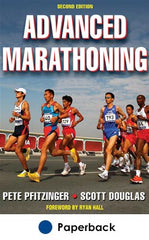Running Form Drills
This is an excerpt from Advanced Marathoning-2nd Edition by Pete Pfitzinger & Scott Douglas.
Your running style is determined by your biomechanics, including the length of your bones, your muscle and tendon flexibility, the strength and endurance of various muscles, and the coordinated contraction pattern of your muscles and the resulting movement of your limbs. Because everyone has a unique physical makeup, there is no ideal or perfect form.
Because running form is determined by your unique makeup, the best way to achieve a more-efficient form is by performing the flexibility and strength training exercises outlined earlier in this chapter. Stride length, for example, is almost always determined naturally by your physiological make-up and is best improved by increasing strength and flexibility. To take another example, excessive forward lean at the waist can be overcome by strengthening the gluteal and abdominal muscles. And trunk instability can be improved through the various core exercises provided in this chapter as well.
But there's something else you can do to improve your form and, therefore, how efficiently you run. You've probably seen sprinters doing various combinations of high-knee running, butt kicks, skipping, and so on. Well, several of these drills are great for distance runners too. First, these exercises can improve your coordination and running form. Second, they lead to gains in strength endurance that can allow you to maintain your stride length throughout a race. Drills up a moderate slope provide even greater resistance. By concentrating on a high knee lift; a complete toe-off; good arm drive; a relaxed neck with the head positioned over the body; relaxed shoulders, arms, and hands; minimal vertical movement (not bouncing with each stride); and an upright posture (not leaning too far forward), you will improve your ability to hold good running form and maximize your running efficiency. When you consider how even a slight flaw in your form will be magnified over the course of a marathon, and when you add the likely scenario of your form, no matter how good, faltering in the last few miles of a marathon, it should be obvious why working to streamline your running technique will help you be a faster marathoner.
When doing drills, the key is to exaggerate various aspects of the running stride and to concentrate on maintaining your form as you begin to fatigue. This attention to various aspects of the running gait will, over time, become ingrained, and pay dividends late in your marathon.
There are endless drills you could do; we've selected four that will significantly help your marathoning. They'll help you maintain your stride length and lessen your ground-contact time, two aspects of running form that can deteriorate with lots of relatively slow marathon training.
You should do drills when you are warmed up but still fresh—there is no use trying to improve your coordination and technique when you are already tired. You'll notice benefits if you do them regularly, at least once, and preferably twice, per week. A good way to easily incorporate drills into your routine is to do them before a session of striders and before harder workouts such as tempo runs and V̇O2max sessions.
Perform the drills as a circuit; that is, do one repetition of each, and then repeat the sequence. Do one repetition of each drill for 15 to 20 meters, and rest before the next one by walking back to the starting point. Visualize yourself completing the drill perfectly.
http://www.humankinetics.com/AcuCustom/Sitename/DAM/128/skipmarchwalk.jpg
Skip March Walk
How to do it:
Begin by walking slowly forward on the balls of your feet using small steps.
Raise one knee to hip level so that your thigh is parallel to the ground.
Rise on the toes of the other foot, straightening your back leg.
Your trunk should be held upright, with your chest out and shoulders back.
Keep your head still and neck relaxed.
Swing your arms forward and back in an exaggerated running motion.
Keep your shoulders, arms, and hands relaxed.
http://www.humankinetics.com/AcuCustom/Sitename/DAM/128/skipmarchrun.jpg
Skip March Run
How to do it:
Adopt the same start posture as for skip march walk.
Follow the same movements as for skip march walk, but increase your leg and arm drive to a moreexaggerated skipping motion.
http://www.humankinetics.com/AcuCustom/Sitename/DAM/128/Kickout.jpg
Kickout
How to do it:
Walk forward slowly on the balls of your feet.
Raise one knee (photo a), and as the knee approaches hip level, straighten the knee to nearly full extension. (Your leg will end up nearly horizontal.)
Allow your momentum to carry your body forward (photo b), and hop on your back leg before stepping forward (photo c) to repeat with the other leg.
Hold your trunk upright, with your head still and your arms swinging forward in a normal running motion.
As you become more adept at the movement over time, progress from walking to jogging while performing the kickouts.
http://www.humankinetics.com/AcuCustom/Sitename/DAM/128/fastfeet.jpg
Fast Feet
How to do it:
In this drill, you run by taking short steps as quickly as possible.
Stay on the balls of your feet at all times, and use a rapid arm movement.
Don't lean too far forward. Try to keep your trunk upright and your head still.
Aging and running each places its own demands on our bodies. Understanding their interrelated effects will help you plan your training and set your goals. You'll be able to remain optimistic but also realistic. If you're just starting a training program, you should always check with your physician first.
Learn more about Advanced Marathoning, Second Edition.
More Excerpts From Advanced Marathoning 2nd Edition

Get the latest insights with regular newsletters, plus periodic product information and special insider offers.
JOIN NOW


